

Imagine the panic and confusion of seeing your beloved Dog suddenly start to stagger and drool uncontrollably, his eyes look strange and he drops to the floor pawing at his mouth? What on earth has happened, he was just fine a few moments ago??
That feeling of helplessness of not knowing what the best thing to do in the immediate moment, whilst trying to locate the nearest available Vet for assistance.
Well, these are quite possibly the first symptoms of an unfortunate and potentially fatal encounter that your dog may have had with a Cane Toad, and you will need to take immediate action.
This article will tell you everything you need to know about Cane Toads, what they are, why they are so dangerous to our Pets, what to do if your Pet comes into contact with one and what steps you can take to protect your Pets from them…. Prevention is better than cure!
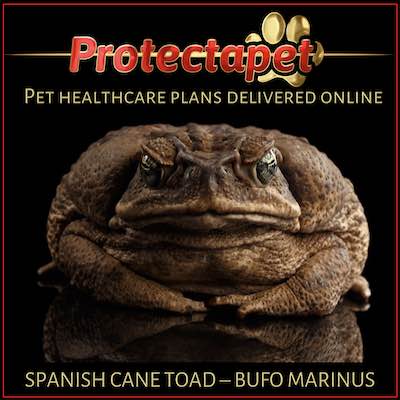 Let´s begin…
Let´s begin…
Cane Toads are also known also as: The Giant Toad, Bufo Toad, Marine Toad, Rhinella Marina - formally Bufo Marinus. In Spanish they are called SAPO DE CAÑA: The Cane Toad is essentially a non-native (originally from Central & South America) amphibian that has spread in numbers massively, due to the fact that they can pretty much eat anything they can fit in their mouths, including – notably, pet food… they are very adaptive in terms of their ability to thrive & survive in various habitats and are poisonous to boot.
Being one of the largest species of Toad in the world they should be easy to spot, however they do tend to be most active between dusk & dawn, so you may need a torch!
Here are some identifiers....
- Adults are large (particularly the females) and heavy looking with short legs. The average size of adults is be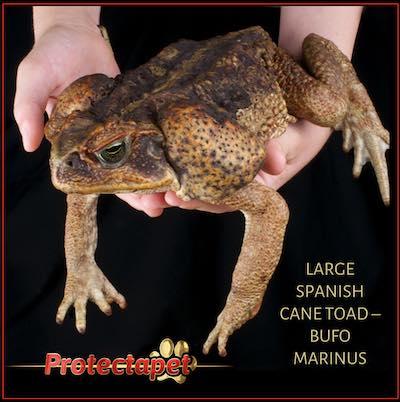 tween 10-15cm, ( 4 to 6 inches) males are smaller and have more warts on their skin, of course immature toads will be much smaller but equally toxic.
tween 10-15cm, ( 4 to 6 inches) males are smaller and have more warts on their skin, of course immature toads will be much smaller but equally toxic.
- Various combinations of Red/Grey/Yellow/Olive Green/Brown. Sometimes there can be also markings of a darker shade with a lighter underbelly. Spotted dark patches on the lighter sides and underbelly of the toads, well camouflaged to most of their surroundings, making them difficult to spot.
- Many irregular warts & bumps, dry looking.
- Cane Toads also have ridges above their “goat like” eyes that join at the snout and large glands situated between their eyes and shoulders… more about them later. It's really ugly and almost prehistoric looking.
– At night time, during the warmer weather and after rain, you may hear their call, it sounds like a low, long trill and here, you can hear what they sound like. This will help you recognise the differences between the call of a Cane Toad and other frogs that might be in your garden, so if you do hear this sound, you will know you have cane toads around.
– They have a pretty upright posture due to their short back legs and they tend to walk or crawl as opposed to jump. They are unable to climb walls due to the fact that they do not have toe pads and only their back feet are webbed, they can however swim and are capable of long distances.
Cane Toads also have ridges above their eyes that join at the snout and large glands (where the poison comes from) situated between their eyes and shoulders… more about these poisonous glands later.
– Being opportunist omnivores, an omnivore is an animal, in this case cane toads, that have the ability to eat and survive on both plant and animal matter. Cane Toads have a wide diet that includes small mammals, insects, vegetation, birds, other toads and lizards, even animal and human faecal material. Some have also developed a taste for human and pet food if its readily available and accessible.
– Cane Toads seem to be able to adapt to a variety of locations worldwide from the rain forest to the desert, and everything in between including urban areas. As they are poor at jumping and climbing they are predomonantly land dwelling and are usually found near a water source.
They can cope with salt water for small periods of time but with a preference for fresh water. during the wet season they are at their most productive with regards to breeding and travel. Cane Toads can survive in dry conditions even if they lose 50% of their body moisture, as I mentioned… extremely adaptable. You are most likely to come across a Cane Toad at night time near a light or water source.
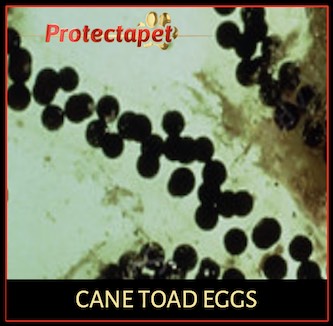
Breeding happens in still or slow moving water and is quite prolific with between 10 and 35 000 eggs being laid, once maybe twice a year if the conditions are optimal, with an approximate of one in 200 survival rate!
Cane Toad sexual maturity is reached between 1 & 2 years, with an average of 5 years of egg production. It has been known for a Cane Toad to survive for up to 15 years in captivity.
When the female is ready to release what is called a “clutch” of eggs, she will head towards the males that will be near a water source. She will be able to detect and select her mate by the sound of his “calling”. Fertilization of the eggs is external, the Male will assume the “amplexus “ position, being that he will cling to the back of the female Cane Toad and use his forearms to hold tightly to her under her armpits. As her eggs are released into the water so is the sperm and this is where fertilization will happen.
You can identify Cane Toad eggs as they look like long string of black beads in a clear plastic, sausage like skin, that are usually found clinging in a jelly like mass to vegetation in the water.
Yes, they are. A preventative measure - Ideally you can remove the eggs from the water and leave to dry out. Please use gloves to do this as Cane toads are poisonous during all stages of their lifecycle.
They are black during the day and may change colour at night, often changing to a paler colour and even almost transparent. They are small in size and are often found moving slowly in shoals just below the water surface as their lungs do not develop as quickly as native tadpoles.
Once they have emerged from the water, the young toads will usually stay near the water´s edge for around one week before moving on independently. It is worth emphasizing again here that Cane Toads are highly poisonous during ALL stages of their lifecycle including post mortem,so always handle with care and with gloves.
Which leads us to …
As mentioned earlier there are two glands located on the back of the Cane Toad, behind it's eyes and just above the shoulders, they are called the Parotoid Glands. These paratoid glands secrete a toxin called Bufotoxin which amongst other chemicals includes Bufotenine (a hallucinogen), Bufagin (affects the heart), adrenaline & serotonin.
These chemicals combined are highly toxic to other amphibians, mammals and humans on contact ( particularly via the mucous membranes).
This milky substance is a highly effective built-in defense system for the Cane Toad. Predators would naturally attempt to eat the Cane Toad, however, the moment that happens or if the Cane Toad feels threatened, the toxin is released from the glands directly into the perpetrators mouth (the Cane Toad can also squirt the poison).
The Cane Toad toxin is a milky white substance and sticky, so it will stick to the gums and roof of the attackers mouth allowing the toxins to be quickly absorbed into the bloodstream via the mucous membranes – the poison can also be absorbed through the tongue, nose & eyes although this is less common.
The effects of the poison are rapid, symptoms will develop based on how much of the toxin is absorbed and the amount of time that passes before medical intervention.
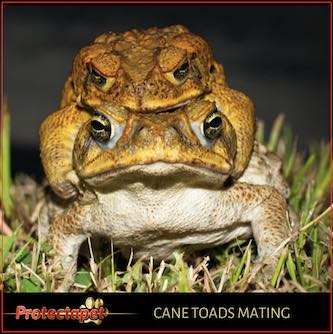 As we know, Dogs will naturally investigate interesting things with their mouths, sniffing, licking and mouthing the Cane Toad, and herein lies the problem! For Cats less so, whilst Cane Toad poisoning in Cats is not unheard of, Cats just seem to steer a wider path of Cane Toads (maybe it´s just good instinct?!)
As we know, Dogs will naturally investigate interesting things with their mouths, sniffing, licking and mouthing the Cane Toad, and herein lies the problem! For Cats less so, whilst Cane Toad poisoning in Cats is not unheard of, Cats just seem to steer a wider path of Cane Toads (maybe it´s just good instinct?!)
Head shaking, drooling, panting, difficulty in breathing, crying, staggering, pawing at the mouth, foaming at the mouth, dilated pupils, tightly clamped jaws, slimy red gums, loss of coordination, disorientation, muscle twitching, tremors, convulsions, seizures, rigidity of body or legs, collapse, trying to vomit, vomiting, diarrhoea, irregular or increased heartbeat, high temperature, death.
Quick identification and therefore a quicker reaction time on your part will be crucial in getting your Pet the help they need in order to survive and recover. Please remember that it could be different for each Dog... they may have only a couple of symptoms or indeed something else completely, so please, only use this information as a guide to the symptoms that may be caused by Cane Toad poisoning.
Ultimately you need to get your dog straight to the nearest Vet. A Cane Toad can secrete enough poison to kill a dog of an average size in approximately 15 minutes so time is of the essence. There are some things that you can do either whilst waiting for a Vet or whilst in transit (if possible), and as always please proceed with caution.
1 – Keep your Pet cool, particularly if they are convulsing.
2 – Do not try to induce vomiting
3– Wearing gloves, use a damp rag or cloth and wipe the inside of your Dog´s mouth including gums, teeth, roof of the mouth and any outer areas. You are looking for a sticky/slimy white substance. Wash or change the rag/cloth between wipes. It is not advised to hose or flush the mouth with water due to the risk of inhalation which in turn could cause pneumonia.
4- If your dog is having a seizure do not attempt the wipe the mouth, do however be cautious as your pet may not recognise you, and could bite.
5- If your dog is unconscious, again do not wipe the mouth.
Once at the Vet, your Dog will be assessed to determine how severely they have been exposed to the toxin and what action needs to be taken.
This could be a number of things, from the continuation of the removal of the toxin, active cooling and medication for high temperature and seizures, oxygen to assist breathing, intravenous fluids to a ECG (Electrocardiogram) to monitor heat rhythm.
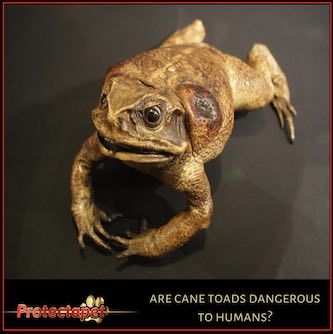
Well in short yes, however to humans, the symptoms seem to be limited to amongst others - severe irritation and /or intense pain to skin, nose, throat & eyes (temporary blindness) and inflammation. This of course is largely due to the fact that we are much less likely to mouth or eat a toad!! Always be mindful if you come across a Cane Toad, especially with small children, they are poisonous. If you do come into contact with the venom, please seek medical advice immediately.
Here are some suggestions and tips on how to protect your Pets (no pun intended!!!) from Cane Toads that I hope you may find useful:
If you do find a Cane Toad, protect your eyes and skin with goggles and rubber gloves if you intend to handle it!
Despite the fact that the Cane Toad toxin has a Hallucinogenic compound in it, you will most probably get ill, not high if you lick it...... Urban legend I´m afraid! (sorry!)
For many years in Spain, properties from the Cane Toad have been used as a treatment for hoof rot, wounds in horses, neck problems and knee inflammation.
this article was written & created by tangalina, copyright and all rights reserved by whitemousemedia.com